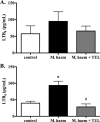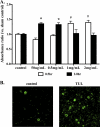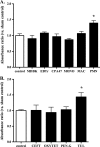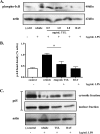Anti-Inflammatory benefits of antibiotic-induced neutrophil apoptosis: tulathromycin induces caspase-3-dependent neutrophil programmed cell death and inhibits NF-kappaB signaling and CXCL8 transcription
- PMID: 20956586
- PMCID: PMC3019645
- DOI: 10.1128/AAC.01052-10
Anti-Inflammatory benefits of antibiotic-induced neutrophil apoptosis: tulathromycin induces caspase-3-dependent neutrophil programmed cell death and inhibits NF-kappaB signaling and CXCL8 transcription
Abstract
Clearance of apoptotic neutrophils is a central feature of the resolution of inflammation. Findings indicate that immuno-modulation and induction of neutrophil apoptosis by macrolide antibiotics generate anti-inflammatory benefits via mechanisms that remain obscure. Tulathromycin (TUL), a new antimicrobial agent for bovine respiratory disease, offers superior clinical efficacy for reasons not fully understood. The aim of this study was to identify the immuno-modulating effects of tulathromycin and, in this process, to establish tulathromycin as a new model for characterizing the novel anti-inflammatory properties of antibiotics. Bronchoalveolar lavage specimens were collected from Holstein calves 3 and 24 h postinfection, challenged intratracheally with live Mannheimia haemolytica (2 × 10(7) CFU), and treated with vehicle or tulathromycin (2.5 mg/kg body weight). Terminal deoxynucleotidyltransferase-mediated dUTP-biotin nick end labeling (TUNEL) staining and enzyme-linked immunosorbent assay (ELISA) revealed that tulathromycin treatment significantly increased leukocyte apoptosis and reduced levels of proinflammatory leukotriene B(4) in M. haemolytica-challenged calves. In vitro, tulathromycin concentration dependently induced apoptosis in freshly isolated bovine neutrophils from healthy steers in a capase-3-dependent manner but failed to induce apoptosis in bovine fibroblasts, epithelial cells, and endothelial cells, as well as freshly isolated bovine blood monocytes and monocyte-derived macrophages. The proapoptotic effects of TUL were also, in part, drug specific; equimolar concentrations of penicillin G, oxytetracycline, and ceftiofur failed to cause apoptosis in bovine neutrophils. In addition, tulathromycin significantly reduced levels of phosphorylated IκBα, nuclear translocation of NF-κB p65, and mRNA levels of proinflammatory interleukin-8 in lipopolysaccharide (LPS)-stimulated bovine neutrophils. The findings illustrate novel mechanisms through which tulathromycin confers anti-inflammatory benefits.
Figures








Similar articles
-
Direct and indirect anti-inflammatory effects of tulathromycin in bovine macrophages: inhibition of CXCL-8 secretion, induction of apoptosis, and promotion of efferocytosis.Antimicrob Agents Chemother. 2013 Mar;57(3):1385-93. doi: 10.1128/AAC.01598-12. Epub 2013 Jan 7. Antimicrob Agents Chemother. 2013. PMID: 23295921 Free PMC article.
-
Tulathromycin exerts proresolving effects in bovine neutrophils by inhibiting phospholipases and altering leukotriene B4, prostaglandin E2, and lipoxin A4 production.Antimicrob Agents Chemother. 2014 Aug;58(8):4298-307. doi: 10.1128/AAC.02813-14. Epub 2014 May 12. Antimicrob Agents Chemother. 2014. PMID: 24820086 Free PMC article.
-
Immunomodulatory effects of tulathromycin on apoptosis, efferocytosis, and proinflammatory leukotriene B4 production in leukocytes from Actinobacillus pleuropneumoniae-or zymosan-challenged pigs.Am J Vet Res. 2015 Jun;76(6):507-19. doi: 10.2460/ajvr.76.6.507. Am J Vet Res. 2015. PMID: 26000598
-
Cyclin-dependent kinase inhibitor drugs as potential novel anti-inflammatory and pro-resolution agents.Br J Pharmacol. 2009 Oct;158(4):1004-16. doi: 10.1111/j.1476-5381.2009.00402.x. Epub 2009 Sep 23. Br J Pharmacol. 2009. PMID: 19775281 Free PMC article. Review.
-
Role of neutrophil apoptosis in the resolution of inflammation.ScientificWorldJournal. 2010 Sep 1;10:1731-48. doi: 10.1100/tsw.2010.169. ScientificWorldJournal. 2010. PMID: 20842319 Free PMC article. Review.
Cited by
-
The immunomodulatory effects of macrolide antibiotics in respiratory disease.Pulm Pharmacol Ther. 2021 Dec;71:102095. doi: 10.1016/j.pupt.2021.102095. Epub 2021 Nov 3. Pulm Pharmacol Ther. 2021. PMID: 34740749 Free PMC article. Review.
-
Penicillin in oral aphthosis, new insight for an old drug: A randomized, double-blind, controlled clinical trial.J Res Med Sci. 2020 Oct 28;25:95. doi: 10.4103/jrms.JRMS_748_19. eCollection 2020. J Res Med Sci. 2020. PMID: 33273940 Free PMC article.
-
Pharmacokinetics of pradofloxacin, florfenicol, and tulathromycin and response to treatment of steers experimentally infected with Mannheimia hemolytica.J Vet Intern Med. 2025 Jan-Feb;39(1):e17270. doi: 10.1111/jvim.17270. J Vet Intern Med. 2025. PMID: 39655779 Free PMC article.
-
Methaphylactic effect of tulathromycin treatment on rumen fluid parameters in feedlot beef cattle.Can J Vet Res. 2016 Jan;80(1):60-5. Can J Vet Res. 2016. PMID: 26733733 Free PMC article. Clinical Trial.
-
Efficacy of Tulathromycin for the Treatment of Foals with Mild to Moderate Bronchopneumonia.J Vet Intern Med. 2017 May;31(3):901-906. doi: 10.1111/jvim.14717. Epub 2017 Apr 19. J Vet Intern Med. 2017. PMID: 28421633 Free PMC article. Clinical Trial.
References
-
- Akgul, C., D. A. Moulding, and S. W. Edwards. 2001. Molecular control of neutrophil apoptosis. FEBS Lett. 487:318-322. - PubMed
-
- Barkett, M., D. Xue, H. R. Horvitz, and T. D. Gilmore. 1997. Phosphorylation of IkappaB-alpha inhibits its cleavage by caspase CPP32 in vitro. J. Biol. Chem. 272:29419-29422. - PubMed
Publication types
MeSH terms
Substances
LinkOut - more resources
Full Text Sources
Medical
Research Materials

